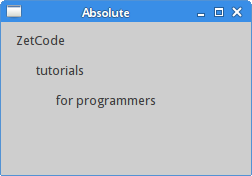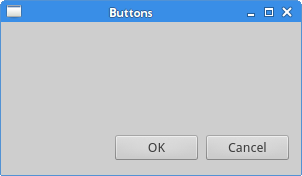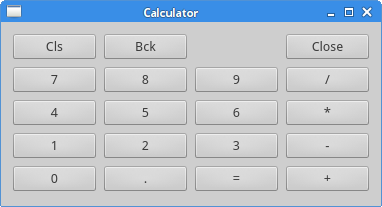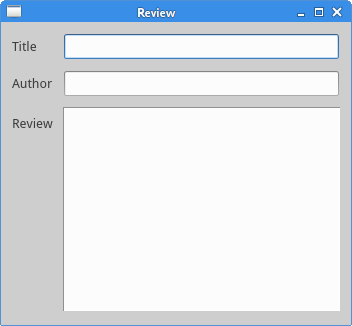PyQt5教程——布局管理(4)
来源:互联网 发布:淘宝封号查询系统 编辑:程序博客网 时间:2024/05/29 10:15
博客园Arthi翻译了zetcode(http://http://zetcode.com/)上的”GUI→PyQt5 tutorial”大部分内容,为了学习用,特地转载其翻译内容。
PyQt5中的布局管理
布局管理是GUI编程中的一个重要方面。布局管理是一种如何在应用窗口上防止组件的一种方法。我们可以通过两种基础方式来管理布局。我们可以使用绝对定位和布局类。
绝对定位
程序指定了组件的位置并且每个组件的大小用像素作为单位来丈量。当你使用了绝对定位,我们需要知道下面的几点限制:
- 如果我们改变了窗口大小,组件的位置和大小并不会发生改变。
- 在不同平台上,应用的外观可能不同
- 改变我们应用中的字体的话可能会把应用弄得一团糟。
- 如果我们决定改变我们的布局,我们必须完全重写我们的布局,这样非常乏味和浪费时间。
-
下面的例子中,使用了绝对坐标来定位组件。
#!/usr/bin/python3# -*- coding: utf-8 -*-"""ZetCode PyQt5 tutorialThis example shows three labels on a windowusing absolute positioning.author: Jan Bodnarwebsite: zetcode.comlast edited: January 2015"""import sysfrom PyQt5.QtWidgets import QWidget, QLabel, QApplicationclass Example(QWidget): def __init__(self): super().__init__() self.initUI() def initUI(self): lbl1 = QLabel('Zetcode', self) lbl1.move(15, 10) lbl2 = QLabel('tutorials', self) lbl2.move(35, 40) lbl3 = QLabel('for programmers', self) lbl3.move(55, 70) self.setGeometry(300, 300, 250, 150) self.setWindowTitle('Absolute') self.show()if __name__ == '__main__': app = QApplication(sys.argv) ex = Example() sys.exit(app.exec_())我们使用move()方法来定位我们的组件。在上面的例子中我们使用move()方法定位了一些标签组件。在使用move()方法时,我们给move()方法提供了x和y坐标作为参数。move()使用的坐标系统是从左上角开始计算的。x值从左到右增长。y值从上到下增长。
lbl1 = QLabel('Zetcode', self)lbl1.move(15, 10)将标签组件定位在x=15,y=10的坐标位置。 
箱布局
布局管理器的布局管理类非常灵活,实用。它是将组件定位在窗口上的首选方式。QHBoxLayout和QVBoxLayout是两个基础布局管理类,他们水平或垂直的线性排列组件。想象一下我们需要在右下角排列两个按钮。为了使用箱布局,我们将使用一个水平箱布局和垂直箱布局来实现。同样为了使用一些必要的空白,我们将添加一些拉伸因子。
#!/usr/bin/python3# -*- coding: utf-8 -*-"""ZetCode PyQt5 tutorialIn this example, we position two pushbuttons in the bottom-right cornerof the window.author: Jan Bodnarwebsite: zetcode.comlast edited: January 2015"""import sysfrom PyQt5.QtWidgets import (QWidget, QPushButton, QHBoxLayout, QVBoxLayout, QApplication)class Example(QWidget): def __init__(self): super().__init__() self.initUI() def initUI(self): okButton = QPushButton("OK") cancelButton = QPushButton("Cancel") hbox = QHBoxLayout() hbox.addStretch(1) hbox.addWidget(okButton) hbox.addWidget(cancelButton) vbox = QVBoxLayout() vbox.addStretch(1) vbox.addLayout(hbox) self.setLayout(vbox) self.setGeometry(300, 300, 300, 150) self.setWindowTitle('Buttons') self.show()if __name__ == '__main__': app = QApplication(sys.argv) ex = Example() sys.exit(app.exec_())例子在右下角放置了两个按钮。当我们改变应用窗口大小时,它们会相对于应用窗口不改变位置。在这个例子中我们使用了QHBoxLayout和QVBoxLayout两个布局类。
okButton = QPushButton("OK")cancelButton = QPushButton("Cancel")在这里我们创建了两个按钮。
hbox = QHBoxLayout()hbox.addStretch(1)hbox.addWidget(okButton)hbox.addWidget(cancelButton)这里我们创建了一个水平箱布局,并且增加了一个拉伸因子和两个按钮。拉伸因子在两个按钮之前增加了一个可伸缩空间。这会将按钮推到窗口的右边。
vbox = QVBoxLayout()vbox.addStretch(1)vbox.addLayout(hbox)为了创建必要的布局,我们把水平布局放置在垂直布局内。拉伸因子将把包含两个按钮的水平箱布局推到窗口的底边。
self.setLayout(vbox)最后,我们设置一下窗口的主布局。 
网格布局
最常用的布局类是网格布局。这个布局使用行了列分割空间。要创建一个网格布局,我们需要使用QGridLayout类。
#!/usr/bin/python3# -*- coding: utf-8 -*-"""ZetCode PyQt5 tutorialIn this example, we create a skeletonof a calculator using a QGridLayout.author: Jan Bodnarwebsite: zetcode.comlast edited: January 2015"""import sysfrom PyQt5.QtWidgets import (QWidget, QGridLayout, QPushButton, QApplication)class Example(QWidget): def __init__(self): super().__init__() self.initUI() def initUI(self): grid = QGridLayout() self.setLayout(grid) names = ['Cls', 'Bck', '', 'Close', '7', '8', '9', '/', '4', '5', '6', '*', '1', '2', '3', '-', '0', '.', '=', '+'] positions = [(i,j) for i in range(5) for j in range(4)] for position, name in zip(positions, names): if name == '': continue button = QPushButton(name) grid.addWidget(button, *position) self.move(300, 150) self.setWindowTitle('Calculator') self.show()if __name__ == '__main__': app = QApplication(sys.argv) ex = Example() sys.exit(app.exec_())在我们的例子中,我们创建了一个全是按钮的网格布局。
grid = QGridLayout()self.setLayout(grid)实例化QGridLayout类,并且把这个类设为应用窗口的布局。
names = ['Cls', 'Bck', '', 'Close', '7', '8', '9', '/', '4', '5', '6', '*', '1', '2', '3', '-', '0', '.', '=', '+']这些标签会在之后的按钮中使用。
positions = [(i,j) for i in range(5) for j in range(4)]我们创建了一个网格的定位列表。
for position, name in zip(positions, names): if name == '': continue button = QPushButton(name) grid.addWidget(button, *position)创建出按钮组件,并使用addWidget()方法向布局中添加按钮。 
文本审阅窗口示例
在网格中,组件可以跨多列或多行。在这个例子中,我们对它进行一下说明。
#!/usr/bin/python3# -*- coding: utf-8 -*-"""ZetCode PyQt5 tutorialIn this example, we create a bitmore complicated window layout usingthe QGridLayout manager.author: Jan Bodnarwebsite: zetcode.comlast edited: January 2015"""import sysfrom PyQt5.QtWidgets import (QWidget, QLabel, QLineEdit, QTextEdit, QGridLayout, QApplication)class Example(QWidget): def __init__(self): super().__init__() self.initUI() def initUI(self): title = QLabel('Title') author = QLabel('Author') review = QLabel('Review') titleEdit = QLineEdit() authorEdit = QLineEdit() reviewEdit = QTextEdit() grid = QGridLayout() grid.setSpacing(10) grid.addWidget(title, 1, 0) grid.addWidget(titleEdit, 1, 1) grid.addWidget(author, 2, 0) grid.addWidget(authorEdit, 2, 1) grid.addWidget(review, 3, 0) grid.addWidget(reviewEdit, 3, 1, 5, 1) self.setLayout(grid) self.setGeometry(300, 300, 350, 300) self.setWindowTitle('Review') self.show()if __name__ == '__main__': app = QApplication(sys.argv) ex = Example() sys.exit(app.exec_())我们创建了包含三个标签,两个单行编辑框和一个文本编辑框组件的窗口。布局使用了QGridLayout布局。
grid = QGridLayout()grid.setSpacing(10)我们创建了一个网格布局并且设置了组件之间的间距。
grid.addWidget(reviewEdit, 3, 1, 5, 1)如果我们向网格布局中增加一个组件,我们可以提供组件的跨行和跨列参数。在这个例子中,我们让reviewEdit组件跨了5行。 
这部分的PyQt5教程专门用于讲述布局管理。
- PyQt5教程——布局管理(4)
- PyQt5教程(三)——布局管理
- PyQt5教程-08-布局管理
- PyQt5中文基础教程4 布局管理
- pyQt5-布局管理
- PyQt5教程——菜单和工具栏(3)
- PyQt5初级教程--PyQt5中的布局管理[5/13]
- PyQt5教程(五)——对话框
- PyQt5教程(六)——控件
- PyQt5教程(七)——控件(II)
- PyQt5教程(八)——拖放
- PyQt5教程(九)——绘图
- PyQt5教程(十)——自定义控件
- PyQt5教程(一)
- Pyqt5系列(九)-基本布局管理
- PyQt5学习记录(3)---布局管理
- PyQt5教程(二)——菜单与工具栏
- PyQt5教程(四)——事件与信号
- 面试--阻止编译优化方法 (46)
- Git远程操作详解
- js的案例
- Java学习笔记1
- 学Android--SharedPreferences
- PyQt5教程——布局管理(4)
- AngularJS—实现根据数量、单价计算总价效果
- C语言训练
- 410款INTEL CPU详细技术资料速查表
- python:SyntaxError:Missing parentheses in call to 'print'
- 1061. 判断题(15)-PAT乙级真题
- postgresql 10 分区探密
- 在Windows上打造出自己的Linux开发环境
- Android基础第九天


